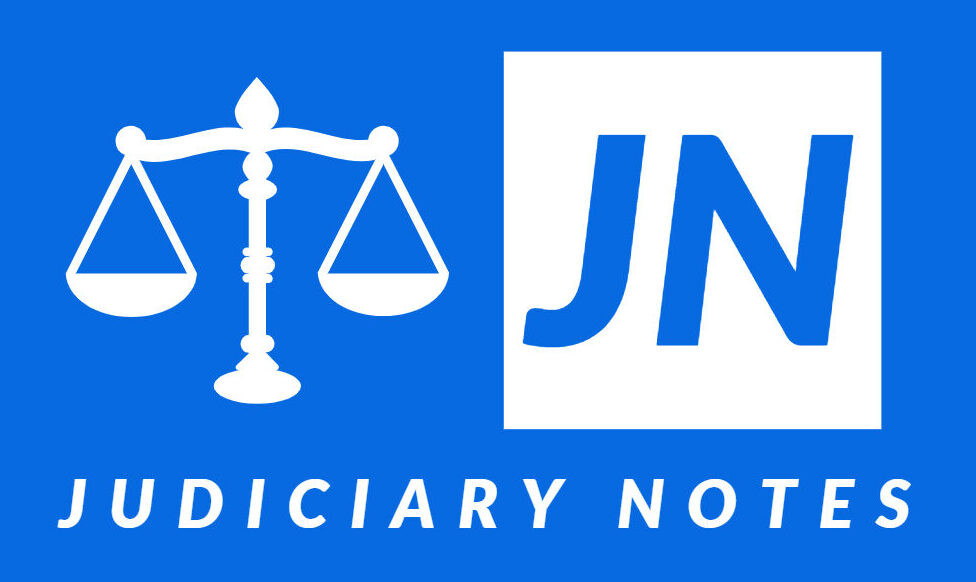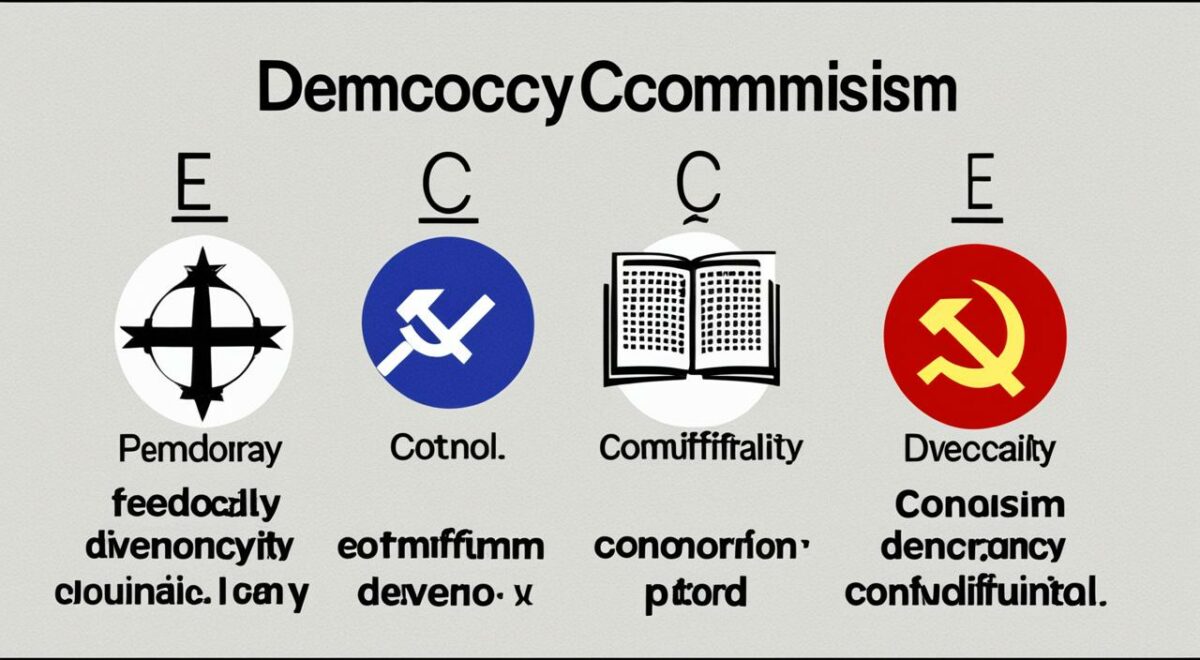Democracy and communism are two different ways to run a country. In a democracy, people own and control the economy. In communism, the state does.
Democracies offer economic and political freedom. Communism doesn’t. These differences have shaped societies and governments over time. They have caused debates and conflicts.
To understand these differences, we must look at their core beliefs and history. This guide explains where they came from, their governments, and their social setups.
Contrasting Ideologies: Democracy and Communism
Democracy and communism have big differences in their ideas. Democracy lets all citizens who can vote have an equal say in their lives. People in a democracy control how they are ruled. They all vote equally in free elections, following the majority’s rule.
Democratic Principles of Freedom and Equality
Democracy stands for freedom of speech, religion, and the press. It also protects individual rights and property. Citizens in a democracy have many freedoms. They can share their views and take part in politics.
Communist Ideals of Class Struggle and Collective Ownership
Communism wants to make a society without classes, where everyone is equal. It believes in sharing the means of production. The goal is to get rid of private property and class differences by changing the capitalist system.
| Democracy | Communism |
|---|---|
| Principles of individual freedom and majority rule | Ideals of class struggle and collective ownership |
| Protection of individual rights and property | Abolition of private property in favor of common ownership |
| Free elections and multi-party system | One-party rule and centralized control |
| Capitalist economic model with private enterprise | Socialist economic model with state-controlled means of production |

“Democracy is the worst form of government, except for all the others.”
– Winston Churchill
Origins and Historical Development
The first democracy started in ancient Athens in the 5th century BC. Citizens were chosen at random for government jobs. The law-making group had all citizens.
Leaders like Solon and Cleisthenes made big changes. But, this democracy ended in 322 BC by the Macedonians.
Ancient Athenian Roots of Democracy
Democracy started in ancient Athens in the 5th century BC. It began in 508-7 BC. Citizens were chosen randomly for jobs and all citizens made laws.
Leaders like Solon and Cleisthenes made big changes. But, it ended in 322 BC by Macedon.
Marx and Engels: Foundations of Communism
Modern communism came from the industrial revolution. Karl Marx and Friedrich Engels wrote the Communist Manifesto in the mid-19th century. They talked about communism’s roots and its goals.
The Communist Manifesto laid the groundwork for communist ideology. It called for ending the capitalist system. They wanted a classless, socialist society.
| Key Figures | Contributions |
|---|---|
| Karl Marx | He is known as the father of communism. He worked with Friedrich Engels on the Communist Manifesto. |
| Friedrich Engels | He helped Karl Marx with communism. Together, they wrote the Communist Manifesto. |

“The proletarians have nothing to lose but their chains. They have a world to win. Working men of all countries, unite!”
– Karl Marx and Friedrich Engels, Communist Manifesto
Government Systems in Democracy vs Communism
Democratic governments and communist governments have big differences in how they work. In democracies, power is spread out among the legislative, executive, and judicial branches. People vote to pick their leaders.
Communist governments, however, have a single Communist party in charge. This party controls the political system, leaving little space for other political views. The state controls the economy and society closely.
| Democratic Government | Communist Government |
|---|---|
|
|
These key differences show how democratic and communist governments are very different.

Social Structures: Class and Property
In democratic capitalist societies, private property rights are key. This leads to different social classes, with wealth and status varying a lot. Even though democracies try to be fair, the free market and private ownership create class differences. Some people have more privilege and resources than others.
Democratic Capitalist Societies with Class Distinctions
Class separation in democratic countries can differ, but social classes are common. These classes are based on income, job, education, and family background. People in the upper and middle classes usually get more chances to succeed. Those in the lower classes might find it hard to move up.
Communist Classless Ideal and Public Ownership
Communism aims for a society without classes, where everyone has the same access to resources. This is done by getting rid of private property and having the community or state own everything. In communism, everyone shares everything, not just owning it.
Today, a few countries like China, Cuba, Laos, North Korea, and Vietnam follow communism. The idea of a classless society motivates many communists. But making this idea work in real life is hard.
democracy vs communism: Fundamental Differences
The main differences between democracy and communism are in their political and economic systems. Democracies have free markets and elected leaders. Communist states have planned economies and rule by one party.
In democracies, people’s rights and freedoms are safe. Citizens can vote for leaders and shape policies. Communist systems focus on the state owning everything. This means people lose some freedoms.
| Characteristic | Democracy | Communism |
|---|---|---|
| Political System | Elected government, multiple political parties | Single-party rule, one-party system |
| Economic System | Free-market capitalism | Centralized, planned economy |
| Ownership | Private property rights | Public/collective ownership |
| Individual Rights | Guaranteed civil liberties, freedom of speech and assembly | Strict state control, limited individual freedoms |
These key differences in how people govern and manage money have led to different paths for democratic and communist countries.
“Democracy is the worst form of government, except for all the others.”
– Winston Churchill
Political Participation and Individual Rights
In democracies, people can vote freely in elections to pick their leaders. They also enjoy freedom of speech, religion, and press. This lets them share their thoughts without fear of state censorship or political repression.
Communist states have a single Communist party in charge. This means little room for political opposition or democratic political participation. Freedom of speech and other rights are often limited or taken away. The state controls information and censors dissent.
Free Elections and Freedom of Speech in Democracies
In democracies, people can vote freely to choose their leaders. This democratic political participation is key. It lets people share different views and change leaders peacefully.
One-Party Rule and State Censorship in Communist Regimes
Communist regimes have a one-party rule. This means one Communist party controls everything. It limits citizens’ democratic political participation. Other political views and opposition are often silenced or censored.
“The collapse of the Soviet Union and the end of the Cold War marked a significant shift in global politics, with the rise of democratic governance and individual freedoms becoming more widespread.”
The difference between democracies and communist states shows how they value political participation and individual rights. This highlights their different beliefs and ways of ruling.
Economic Models: Free Market vs Centralized Planning
Democratic and communist systems have very different economic models. Democracies often use free-market capitalist economies. Here, people and companies decide what to produce and sell based on what people want and can afford. Communist states usually go for centrally planned economies. The government controls everything to make sure everyone is equal and needs are met.
In a free-market economy, people and businesses make choices based on prices and competition. This leads to new ideas, better efficiency, and many choices for consumers. But, it can also mean some people have a lot more than others. Communist systems try to share resources fairly and stop some from getting too rich. But, they might cause shortages and limit what people can choose from.
| Free Market Economy | Centralized Economy |
|---|---|
| Decentralized decision-making | Centralized government control |
| Private ownership of means of production | Public/state ownership of means of production |
| Prices determined by supply and demand | Prices set by the government |
| Incentive for innovation and efficiency | Potential for shortages and inefficiencies |
| Income inequality | Emphasis on equality |
Most economies today mix both free-market and centralized planning. Governments often step in to fix economic problems and ensure everyone has basic needs met. Some communist countries have also added market elements to make things more efficient and give people more choices. The debate on which economic model is best keeps going.
“The inherent vice of capitalism is the unequal sharing of blessings; the inherent virtue of socialism is the equal sharing of miseries.” – Winston Churchill
Modern Examples and Remnants
Today, over half the world’s countries are modern democracies. This includes the United States, Canada, and many European countries. They all have different governments but share key values. These are free elections, a representative government, and protecting individual rights.
Democratic Nations Worldwide
Communist governments were once very common, but not anymore. After the Soviet Union fell in 1991, only a few countries call themselves communist. China, Cuba, Laos, North Korea, and Vietnam are these countries. But, communism in these places has changed a lot from its original idea.
Remnants of 20th Century Communist States
Most countries today are just symbols of old monarchies. In some places like Oman, the Sultan has ruled since the 1970s. In others, like Great Britain and Canada, the monarch doesn’t have much power. Instead, elected leaders take charge.
Some say the United States is more like an oligarchy. Big companies and Wall Street bosses help make decisions. Russia is seen as another example of an oligarchy after communism. There, business leaders have a lot of power.
Ongoing Debates and Future Trajectories
The debate between communism and democracy is still going strong. People argue about things like how well they work and how free they make people. As things change, it’s hard to say what will happen next. Some countries are even trying to mix parts of both systems together.
The debates show how different communism and democracy really are. Democracy fans talk about rights, free markets, and having a say in government. Communism supporters like the idea of everyone owning things together and a strong leader in charge. These big differences have shaped politics for a long time.
Looking ahead, it’s hard to predict what will happen with these ideas. Some places, like China, are mixing capitalist ways with strong government control. In democracies, there are big issues like unequal wealth, political fights, and the rise of strong leaders. The debate between communism and democracy keeps affecting people’s lives all over the world. Finding the best way to govern is still a big challenge.

